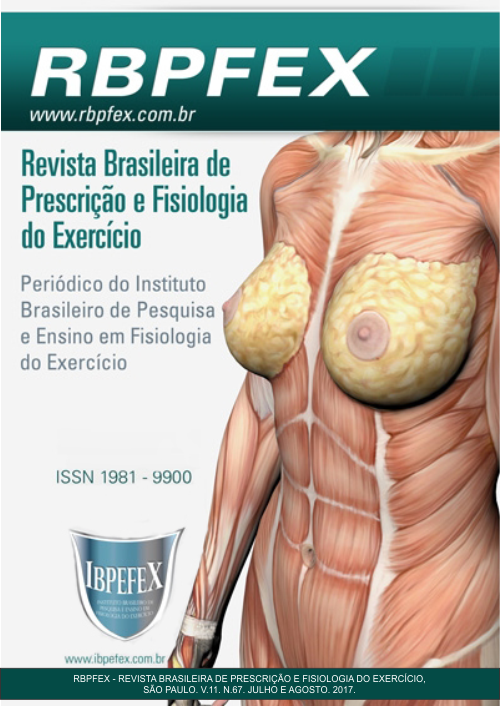Analysis of the correlation between the intensity of effort corresponding to the obla and the glycemic threshold
Abstract
The aim o the study was to investigate the glycemic and lactacidemic responses in corridors in order to verify the existence of a correlation between the rate corresponding to OBLA and the glycemic threshold obtained by a progressive treadmill test. The sample consisted of active men who practice running, aged between 25 and 35 years. All were submitted to a protocol for the incremental test in treadmill in increments of 1 km/h every 3 minutes. In all stages, glucose concentrations, lactacidemia, perception of exertion, and heart rate were obtained. For the statistical analysis, the paired t-test was used to compare the lactate and glycemia concentrations and the correlation between these variables will be determined by the Pearson correlation test (p<0.05). The results showed that there was no high correlation (p<0.05) between blood lactate and blood glucose levels at intensities above the anaerobic threshold. Thus, due to multifactorial influence, it is suggested food control and other variables that may influence oblation when using the fixed value for blood lactate concentration.
References
-Barbosa, L. F.; e colaboradores. Máxima fase estável de lactato sanguíneo e o limite superior do domínio pesado em ciclistas treinados. Revista Brasileira de Cineantropometria e Desempenho Humano. Vol. 11. Núm. 3. p. 320-325. 2009.
-Borg, G.A. Psychophysical bases of perceived exertion. Medicine Science Sports Exercise. Vol. 14. Núm. 5. p. 377-381. 1982.
-Borresen, J.; Lambert, M. The quantification of training load, the training response and the effect on performance. Sports Medicine. Vol. 39. Núm. 9. p. 779-795. 2009.
-Brandão, D.A.; e colaboradores. Comparação entre as respostas sanguíneas de glicemia e lactato durante um teste progressivo em esteira rolante em sujeitos fisicamente ativos. Fitness e Performance Journal. Vol. 9. Núm. 1. p. 113-119. 2010.
-Ferreira, C.; e colaboradores. Comparação entre velocidade no limiar anaeróbico e velocidade crítica em corredores meio-fundistas. ACTA Brasileira do Movimento Humano, Ji-Paraná. Vol. 4. Núm. 5. p. 17-31. 2015.
-Heck, R.; e colaboradores. Justification of the 4-mmol/l lactate threshold.International Journal of Sports Medicine. Vol. 6. Núm. 3. p. 117-130. 1985.
-Kindermann, K. R.; e colaboradores. The significance of the aerobic-anaerobic transition for the determination of work load intensities during endurance training. European Journal of Applied Physiology and Occupational Physiology. Vol. 42. Núm. 1. p. 25-34. 1979.
-Murakami, I.; e colaboradores. Significant Effect of a Pre-Exercise High-Fat Meal after a 3-Day High-Carbohydrate Diet on Endurance Performance. Nutrients. Vol. 4. Núm. 1. p. 625-637. 2012.
-Oliveira, J.C.; e colaboradores. Identificação do limiar de lactato e limiar glicêmico em exercícios resistidos.Revista Brasileira de Medicina do Esporte. Vol. 12. Núm. 6. p. 333-338. 2006.
-Pacheco, M. E.; e colaboradores. Relação entre velocidade crítica, limiar anaeróbio, parâmetros associados ao VO2max, capacidade anaeróbia e custo de O2 submáximo. Motriz. Vol. 12. Núm. 2. p. 103-111. 2006.
-Quirion, A.; e colaboradores. Lactate threshold and onset of blood lactate accumulation during incremental exercise after dietary modifications. European Journal of Applied Physiology and Occupational Physiology. Vol. 57. Núm. 2. p. 192-197. 1988.
-Silva, A. E. L.; Oliveira, F. R. Estimativa dos limiares ventilatórios através da velocidade máxima em teste incremental.Revista Motriz. Vol. 10. Núm. 1. p. 37-44. 2004.
-Simões, H.G.; e colaboradores. Blood glucose responses in humans mirror lactate responses for individual anaerobic threshold and for lactate minimum in track tests.European Journal of Applied Physiology and Occupational Physiology. Vol. 80. Núm. 1. p. 34-40. 1999.
-Simões, H. G.; e colaboradores. Determinação do limiar anaeróbio por meio de dosagens glicêmicas e lactacidêmicasem testes de pista para corredores. Revista Paulista de Educação Física. Vol. 12. Núm. 1. p. 17-30. 1998.
-Svedahl, K.; Macintosh, B.R. Anaerobic threshold: the concept and methods of measurement. Canadian Journal of Applied Physiology. Vol. 28. Núm. 2. p. 299-323. 2003.
-Thomas, J. R.; Nelson, J.K.; Silverman, Stephen J. Métodos de pesquisa em atividade física. Artmed Editora. 2009.
-Wasserman, K.; Mcilroy, M.B. Detecting the threshold of anaerobic metabolism in cardiac patients during exercise. The American journal of cardiology. Vol. 14. Núm. 6. p. 844-852. 1964.
-Yoshida, T. Effect of dietary modifications on lactate threshold and onset of blood lactate accumulation during incremental exercise. European Journal of Applied Physiology and Occupational Physiology. Vol. 53. Núm. 3. p. 200-205. 1984.
Authors who publish in this journal agree to the following terms:
- Authors retain the copyright and grant the journal the right of first publication, with work simultaneously licensed under the Creative Commons Attribution License BY-NC which allows the sharing of the work with acknowledgment of the authorship of the work and initial publication in this journal.
- Authors are authorized to enter into additional contracts separately for non-exclusive distribution of the version of the work published in this journal (eg, publishing in institutional repository or book chapter), with acknowledgment of authorship and initial publication in this journal.
- Authors are allowed and encouraged to post and distribute their work online (eg, in institutional repositories or on their personal page) at any point before or during the editorial process, as this can bring about productive change as well as increase impact and impact. citation of published work (See The Effect of Free Access).






